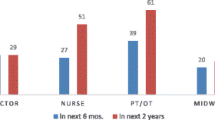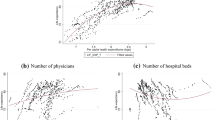Abstract
To identify which MCH services delivered by local health departments (LHD) appear associated with reducing differences in Black–White mortality. We used a time-trend design to investigate relationships between change in MCH activities provided by LHDs in 1993 and in 2005 and changes in 1993–2005 Black–White mortality disparities. Secondary data were analyzed for 558 US counties and multi-county districts. Independent variables included the six MCH services provided by LHDs and captured in the 1993 and 2005 NACCHO Profile of Local Public Health Departments surveys. MCH service variables represented change in each service from 1993 to 2005. Control variables included selected LHD characteristics and county-level socioeconomic, demographic, and health provider resource data. Absolute change in Black and White mortality rates and changes in the mortality disparity “gap” between these rates in 1993 and 2005 were examined as dependent variables. Among the MCH services examined, prenatal care had a significant beneficial relationship with Black all-age mortality change and with reducing the mortality “gap.” Family planning services had a beneficial relationship with reducing the mortality “gap” for females in the jurisdictions in the study sample. WIC services indicated the most consistently beneficial relationship with both Black mortality and White mortality change, but these changes did not influence the mortality “gap” during the study period. LHD delivery of family planning and prenatal care by LHDs appears related to reductions in Black–White mortality disparities. Implications of this study suggest the importance of certain MCH services for reducing Black–White mortality disparities.

Similar content being viewed by others
References
Brown, D. W. (2009). The dawn of healthy people 2020: A brief look back at its beginnings. Preventive Medicine, 48(1), 94–95.
Orsi, J., Margellos-Anast, H., & Whitman, S. (2010). Black–White health disparities in the United States and Chicago: A 15-year progress analysis. American Journal of Public Health, 100(2), 349–356.
Harper, S., Lunch, J., Burris, S., & Davey Smith, G. (2007). Trends in the black–white life expectancy gap in the United States, 1983–2003. Journals American Medical Association, 297(11), 1224–1232.
Shin, P., Jones, K., & Rosenbaum, S. (2003, September). Reducing racial and ethnic health disparities: Estimating the impact of high health center penetration in low-income communities. National Association of Community Health Centers. www.gwhealthpolicy.org/downloads/GWU_Disparities_Report.pdf. Accessed 01/15/08.
Khanani, I., Elam, J., Hearn, R., Jones, C., & Maseru, N. (2007). The impact of prenatal WIC participation on infant mortality and racial disparities. American Journal of Public Health, 100 Suppl 1, S204–209.
Ghosh, T. S., Patnaik, J. L., Bennett, A., Trefren, L., & Vogt, R. L. (2007). Assessment of missing immunizations and immunization-related barriers among WIC populations at the local level. Public Health Reports, 122(5), 602–606.
Wightkin, J., Magnus, J. H., Farley, T. A., Boris, N. W., & Kotelchuck, M. (2007). Psychosocial predictors of being an underweight infant differ by racial group: a prospective study of Louisiana WIC program participants. Maternal and Child Health Journal, 11(1), 49–55.
Frost, J. J., Frohwirth, L., & Purcell, A. (2004). The availability and use of publicly funded family planning clinics: US trends, 1994–2001. Perspectives on Sex and Reproductive Health, 36(5), 206–215.
Selby-Harrington, M. L., & Riportella-Muller, R. (1993). Easing the burden on health departments: A cost-effective method for public health nurses to increase private sector participation in the early and periodic screening, diagnosis, and treatment program. Public Health Nursing, 10(2), 114–121.
Mete, C., Cioffi, J. P., & Lichtveld, M. Y. (2003). Are public health services available where they are most needed? An examination of local health department services. Journal of Public Health Management and Practice, 9(3), 214–223.
NACCHO. (2005). Operational definition of a functional local health department. National Association of County and City Health Officials. http://www.naccho.org/topics/infrastructure/documents/OperationalDefinitionBrochure.pdf. Accessed 01/7/08.
NACCHO. (2010). Trends in local health department finances, workforce, and activities: Findings from the 2005 and 2008 National profile of local health departments studies: National association of county and city health officials.
Keene, C., Marx, J., & Ricci, E. (2003). Local health departments’ mission to the uninsured. Journal of Public Health Policy, 24(2), 130–149.
Lo Sasso, A. T., & Byck, G. R. (2010). Funding growth drives community health center services. Health Affairs, 29(2), 289–296.
NACCHO. (2005). National Profile of Local Health Departments. Washington, D.C.: NACCHO.
Mays, G., Scutchfield, F., Bhandari, M., & Smith, S. (2010). Understanding the organization of public health delivery systems: An empirical typology. Milbank Quarterly, 88(1), 81–111.
Zahner, S. J., & Gredig, Q. N. (2005). Public health nursing practice change and recommendations for improvement. Public Health Nursing, 22(5), 422–428.
NACCHO. (2010). Local health department job losses and program cuts: Findings from January/February 2010 survey; May 2010. Research brief.: National Association of County and City Health Officials.
Frohlich, K. L., & Potvin, L. (2008). Transcending the known in public health practice: the inequality paradox: The population approach and vulnerable populations. American Journal of Public Health, 98(2), 216–221.
Alio, A., Richman, A., Clayton, H., Jeffers, D., Wathington, D., & Salihu, H. (2009). An ecological approach to understanding Black–White disparities in perinatal mortality. Maternal and Child Health Journal, 14(4), 557–566.
Green, L. W. (2006). Public health asks of systems science: To advance our evidence-based practice, can you help us get more practice-based evidence? American Journal of Public Health, 96(3), 406–409.
Iton, A. B. (2008). The ethics of the medical model in addressing the root causes of health disparities in local public health practice. Journal of Public Health Management and Practice, 14(4), 335–339.
Bekemeier, B., Grembowski, D., Yang, Y., & Herting, J. (2011). under review. Local health department changes in service: Relationships to health disparities.
Grembowski, D., Bekemeier, B., Conrad, D., & Kreuter, W. (2010). Are local health department expenditures related to racial disparities in mortality? Social Science and Medicine, 71(12), 2057–2065.
Rajaratnam, J. K., Burke, J. G., & O’Campo, P. (2006). Maternal and child health and neighborhood context: The selection and construction of area-level variables. Health Place, 12(4), 547–556.
Robert, S. A., & Reither, E. (2004). A multilevel analysis of race, community disadvantage, and body mass index among adults in the US. Social Science and Medicine, 59(12), 2421–2434.
Hajat, A., Cilenti, D., Harrison, L. M., MacDonald, P. D. M., Pavletic, D., Mays, G. P., et al. (2009). What predicts local public health agency performance improvement? A pilot study in North Carolina. Journal of Public Health Management and Practice, 15(2), E22–E33.
Bigbee, J. (2008). Relationships between nurse- and physician-to-population ratios and state health rankings. Public Health Nursing, 25(3), 244–252.
Shi, L., & Starfield, B. (2001). The effect of primary care physician supply and income inequality on mortality among blacks and whites in US metropolitan areas. American Journal of Public Health, 91(8), 1246–1250.
Plough, A. (2004). Understanding the financing and functions of metropolitan health departments: a key to improved public health response. Journal of Public Health Management and Practice, 10(5), 421–427.
Mays, G. P., McHugh, M. C., Shim, K., Perry, N., Lenaway, D., Halverson, P. K., et al. (2006). Institutional and economic determinants of public health system performance. American Journal of Public Health, 96(3), 523–531.
Mays, G. P., & Smith, S. A. (2010). Effects of local public health spending on population health: Does more money matter? Health Services Research, in press.
Thornburg, K. L., Shannon, J., Thuillier, P., & Turker, M. S. (2010). In utero life and epigenetic predisposition for disease. Advances in Genetics, 71, 57–78.
Chmurzynska, A. (2010). Fetal programming: Link between early nutrition, DNA methylation, and complex diseases. Nutrition Reviews, 68(2), 87–98.
Roberts, C., Algert, C., Mueller, L., & Hadler, J. (1997). Trends in infant mortality in Connecticut, 1981–1992. Journal of Public Health Management and Practice, 3(5), 50–57.
Pestronk, R., Franks, M., Team, R., Team, H. S., & Team, P. (2003). A partnership to reduce African American infant mortality in Genesee County, Michigan. Public Health Reports, 118(4), 324–335.
Acknowledgments
Funding support was provided from Pfizer Scholars Grants in Public Health and the University of Washington School of Nursing’s Van Hooser Gift Fund.
Author information
Authors and Affiliations
Corresponding author
Rights and permissions
About this article
Cite this article
Bekemeier, B., Grembowski, D., Yang, Y.R. et al. Local Public Health Delivery of Maternal Child Health Services: Are Specific Activities Associated with Reductions in Black–White Mortality Disparities?. Matern Child Health J 16, 615–623 (2012). https://doi.org/10.1007/s10995-011-0794-9
Published:
Issue Date:
DOI: https://doi.org/10.1007/s10995-011-0794-9




